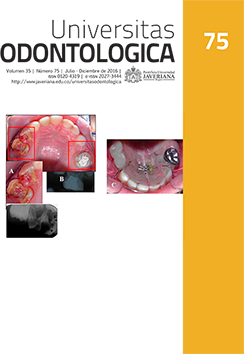Abstract
RESUMEN. Antecedentes: La avulsión es un tipo de lesión traumática poco frecuente en la dentición permanente. La reabsorción radicular externa es un evento común posterior al reimplante de un diente avulsionado. Objetivo: Reportar un caso de trauma de dos dientes reimplantados, en el que se obtuvieron resultados satisfactorios con 26 semanas de seguimiento. Reporte del caso: Manejo clínico de paciente de sexo masculino de 8 años de edad que se presenta a la clínica del Postgrado de Endodoncia de la Universidad de Cartagena, Colombia, con antecedente de avulsión y posterior reimplante con ferulización de los dos incisivos centrales superiores. Los dientes fueron preparados hasta lima 50 tipo K, medicados con hidróxido de calcio y obturados con MTA. Resultados: Se observó cicatrización de la superficie radicular con disminución de las zonas de reabsorción externa radicular después de 26 semanas de seguimiento. Conclusión: La reabsorción radicular externa en dientes avulsionados reimplantados puede contrarrestarse en la medida que hayan sido manejados con conocimiento profesional, dentro de un marco de tiempo y condiciones biológicas.
ABSTRACT. Background: Dental avulsion is a rare traumatic lesion in permanent teeth. External root resorption is a common event after reimplantation of an avulsed tooth. Purpose: To report a case of two reimplanted teeth with satisfactory results after controls during 26 weeks. Case report: Clinical management of an 8-year-old boy that seeks attention in the clinic of the Postdoctoral Program in Endodontics of University of Cartagena with background of avulsion of both central upper incisors. The teeth were prepared up to a type K # 50 file, medicated with calcium hydroxide and later filled with MTA. Results: Healing was observed on the root surface with reduction of the external radicular resorption after a 26-week follow-up. Conclusion: External radicular resorption can be counteracted as long as its handling was performed professionally within parameters of time and biological conditions.
de Jesus Soares A, do Prado M, Farias Rocha Lima T, Gomes BP, Augusto Zaia A, Jose de Souza-Filho F. The multidisciplinary management of avulsed teeth: a case report. Iranian Endod J. 2012; 7(4): 203-6.
Zhou Y, Li Y, Mao L, Peng H. Periodontal healing by periodontal ligament cell sheets in a teeth replantation model. Arch Oral Biol. 2012; 57(2): 169-76.
Marão HF, Panzarini SR, Aranega AM, Sonoda CK, Poi WR, Esteves JC, Silva PI. Periapical tissue reactions to calcium hydroxide and MTA after external root resorption as a sequela of delayed tooth replantation. Dent Traumat. 2012; 28(4): 306-13.
Pohl Y, Filippi A, Kirschner H. Results after replantation of avulsed permanent teeth. II. Periodontal healing and the role of physiologic storage and antiresorptive-regenerative therapy. Dental Traumatol. 2005; 21(2): 93-101.
Werder P, von Arx T, Chappuis V. Treatment outcome of 42 replanted permanent incisors with a median follow-up of 2.8 years. Schweiz Monatsschr Zahnmed. 2011; 121(4): 312-20.
Trope M. Avulsion of permanent teeth: theory to practice. Dental Traumat. 2011; 27(4): 281-94.
Goswami M, Chaitra T, Chaudhary S, Manuja N, Sinha A. Strategies for periodontal ligament cell viability: An overview. J Conserv Dent. 2011; 14(3): 215-20.
Emerich K, Czerwinska M, Ordyniec-Kwasnica I. Immediate self-replantation of an avulsed permanent mandibular incisor - a case report. Dental Traumatol. 2010; 26(5): 443-6.
Finucane D, Kinirons MJ. External inflammatory and replacement resorption of luxated, and avulsed replanted permanent incisors: a review and case presentation. Dental Traumatol. 2003; 19(3): 170-4.
Pohl Y, Filippi A, Kirschner H. Results after replantation of avulsed permanent teeth. I. Endodontic considerations. Dental Traumatol. 2005; 21(2): 80-92.
Pohl Y, Wahl G, Filippi A, Kirschner H. Results after replantation of avulsed permanent teeth. III. Tooth loss and survival analysis. Dental Traumatol. 2005; 21(2): 102-10.
This journal is registered under a Creative Commons Attribution 4.0 International Public License. Thus, this work may be reproduced, distributed, and publicly shared in digital format, as long as the names of the authors and Pontificia Universidad Javeriana are acknowledged. Others are allowed to quote, adapt, transform, auto-archive, republish, and create based on this material, for any purpose (even commercial ones), provided the authorship is duly acknowledged, a link to the original work is provided, and it is specified if changes have been made. Pontificia Universidad Javeriana does not hold the rights of published works and the authors are solely responsible for the contents of their works; they keep the moral, intellectual, privacy, and publicity rights.
Approving the intervention of the work (review, copy-editing, translation, layout) and the following outreach, are granted through an use license and not through an assignment of rights. This means the journal and Pontificia Universidad Javeriana cannot be held responsible for any ethical malpractice by the authors. As a consequence of the protection granted by the use license, the journal is not required to publish recantations or modify information already published, unless the errata stems from the editorial management process. Publishing contents in this journal does not generate royalties for contributors.


